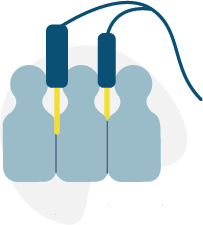2. CERVICAL RHIZOLYSIS
The lesion is made with radiofrequency on the medial branch of the cervical nerve, which supplies the zigoapofisary intervertebral joint, the supraspinatus and interspinous ligaments and deep muscles (multifidus, interspinal).
This procedure can be done using one of several approaches. Based on our experience, we use the lateral approach because it offers technical advantages and greater comfort for the patient on the operating table. For this approach, the patient is placed on his back with slight hyperextension of the chin.
As in the procedure in the lumbar region, cervical rhizolysis is performed using local anesthesia and light sedation. In lateral projection, we locate the levels to be treated and then we mark the center of the cervical zygopophyseal joint, which in this projection has the shape of a “rhombus”. The needle is carefully inserted in the direction of the target point (located in the center of the rhombus shape) using a radiological view of the tunnel, until it touches the bone. In the anteroposterior view of the fluoroscope, the correct position of the needle at the tip of the joint is checked.
Before making the lesion, each needle is used to perform a sensitive stimulation (50Hz to 0.5V), during which the patient notices paresthesias (“pins and needles”) or a sensation of pressure in the stimulated neck area. The stimulation may also cause the patient to feel the pain they were suffering, but it does not irradiate.
Next, we perform motor stimulation (2Hz to 2V), with may cause fasciculations of the paraspinal musculature to appear, which must also not show rhysoroot distribution. At Instituto Clavel we perform this rhizolysis using pulsed radiofrequency following a 45V protocol for 120 seconds. One or more levels from C2 to C7 can be treated unilaterally or bilaterally.


